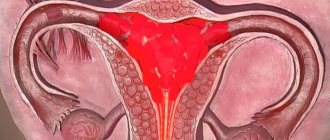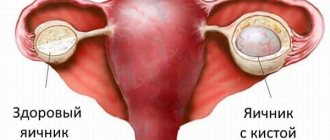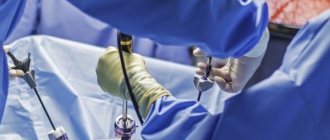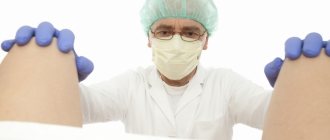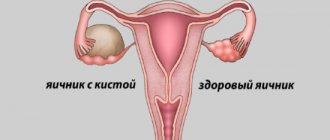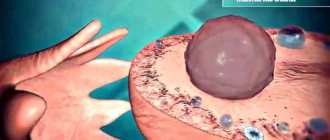Diet after laparoscopy of an ovarian cyst is one of the stages of the transition to a full, healthy life. Modern methods of surgical intervention in the treatment of female gynecological diseases, in particular ovarian cysts, are based on the method of laparoscopy (Fig. 1), which from ancient Greek means “look into the womb.” The operation does not require one large incision, but 3-4 holes with a diameter of about 1 cm are made for a laparoscope and several surgical instruments. Although this operation is considered more gentle than the old method, after its completion some rehabilitation is required.
Fig.1. Ovarian surgery
Why is a dietary diet necessary?
Experts promise a quick recovery (3-4 days) and a transition to normal everyday life for patients who have undergone laparoscopy. Therefore, proper nutrition after removal of an ovarian cyst is an important factor. Let's look at the main indicators that improve a woman's rehabilitation thanks to a reasonable diet after laparoscopy:
- A balanced diet rich in minerals and vitamins is a good source of healthy hormonal levels in the female body, which normalizes the menstrual cycle and reproductive function of the ovaries.
- A proper diet and high-quality fluid intake accelerates the elimination of toxins from the body that appear during any type of anesthesia.
- The diet after removal of an ovarian cyst facilitates the digestion process, eliminating the occurrence of gases and constipation, which can affect the operated area through the intestines. Tightening the muscle tissue in your abdomen will make it difficult for your wounds to heal.
- Healthy food with vitamins accelerates the regenerative functions of the patient’s body (Fig. 2), reducing the risks of postoperative complications.
Fig.2 Scars after laparoscopy
Conclusion: It is necessary to follow the diet recommended by your doctor for a quick recovery and reduce the possibility of complications.
Advantages of laparoscopy over laparotomy
The methods are similar in purpose; the result of each manipulation is the removal of the pathological focus. The difference lies in the features of access, the technique of how the operation is performed, the duration of the process and the speed of rehabilitation.
The techniques are performed under general anesthesia (anesthesia). By introducing special agents into a vein and tracheal intubation. In some cases, epidural anesthesia may be performed at the discretion of the anesthesiologist and gynecologist.
Access using the laparoscopic technique – 3 small punctures ranging in size from 5 mm to 15 mm.
Laparotomy - involves a layer-by-layer incision of tissue (skin, subcutaneous fat, muscles) with wide access.
The length varies from 9 to 15 cm. The operating gynecologist directly sees the cavity with the uterus and appendages with his eyes. In the process, the ovarian cyst is excised with a scalpel and other surgical instruments. In compliance with the rules of asepsis, the surgical cavity is processed and sutured.
Other advantages of laparoscopy over classical surgery:
- Less traumatic.
- Small access with a reduced risk of postoperative infectious and inflammatory complications.
- The risk of formation of adhesions after laparoscopy is very small - there is no compression of adjacent organs, contact with surgical material, or contact with dilators.
- The rehabilitation period is faster, the term of disability is shorter.
- The risk of suture material dehiscence is reduced to zero.
- Invisible scars after laparoscopy.
- Rarely, postoperative hernial protrusions and intestinal hypotension with persistent constipation occur.
It is used as an additional method for diagnosing gynecological diseases. Makes it possible to visualize the woman’s internal genital organs and take a biopsy sample.
How is the operation performed?
- The anesthesiologist and gynecologist determine the method of anesthesia (usually general). In the operating room, the woman is placed on a special couch with the head end down.
- Upon reaching the surgical stage of anesthesia, they begin to create a laparoscopic approach. A Veress needle is inserted through the first intraumbilical incision to create pneumoperitoneum.
- The needle is removed and a trocar with a small video camera and a beam of light is inserted. The further picture of the operation is displayed on the monitor and displayed in real time.
The operating doctor examines and evaluates the condition of the organs, as well as the ovarian cyst. Through an additional 2 punctures, trocars with surgical instruments are inserted, which ensures enucleation and removal of the unwanted ovarian formation.
At the end of the surgical process, the manipulators and video camera are removed, and the access points are sutured with cosmetic suture material.
Indications for surgery
Functional ovarian cysts, such as follicular and luteal cysts, do not require urgent surgery for small volumes. Conservative therapy is prescribed for a period of 2–3 months. Nevertheless, such ovarian formations are hormone-dependent and tend to grow.
Diet before laparoscopy of ovarian cyst
In addition to blood tests, ultrasound, and taking certain medications, preparation for surgery includes a special diet:
- 4-5 days before the planned laparoscopy procedure for ovarian cysts, a woman should not eat food that causes the formation of gases in the intestines (Fig. 3) - milk, brown bread, peas, soybeans, beans, beans, cabbage, raw vegetables, fruits, sweets , carbonated drinks.
- Recommended products include boiled lean meat, boiled fish, porridge, and broth.
- On the last day before surgery, you can only have breakfast, you can eat broth for lunch, and you can drink water for dinner. An enema must be given in the evening.
- The patient should fast 8-9 hours before the operation. In the morning, the intestines are also cleansed with an enema.
Fig. 3 Foods that cause gas in the intestines
Postoperative diet rules
Nutritionists and doctors recommend eating more frequently—up to six or seven times a day. Portions should be small so as not to overload the gastrointestinal tract and the body. The diet should help strengthen the body, but at the same time not take away excess energy for digesting food.
For the first three days after abdominal surgery, you should only consume food diluted with water:
- low-fat broths;
- jelly, compotes, weak tea;
- decoctions of medicinal herbs;
- natural juices diluted with water;
- fruit/berry jelly.
What can you eat after laparoscopy of an ovarian cyst?
A diet after laparoscopy is recommended by the attending physician depending on the individual characteristics of the patient, her tests and the successful course of the operation. Experts have developed basic nutritional rules after ovarian surgery:
- It is necessary to eat warm, not hot foods, to avoid irritation of the stomach walls.
- Cook broths from low-fat fillets, removing the skin from the chicken.
- Eat small portions of 200-300 g every 3.5-4 hours.
- Process food by stewing or steaming (make soups without fried onions).
- For better absorption of food, you can grind it with a blender (mashed soups, potatoes, boiled vegetables).
- You should not suddenly change your diet, gradually moving from easily digestible foods to more coarse ones.
- Fruits are eaten only in processed form (for example, baked apples).
Important! The operated woman must empty her bowels every day. If constipation occurs, consult your doctor who will prescribe enemas.
The first day after surgery
The first day after laparoscopy of a cyst is quite difficult for a woman, as pain may occur in the groin area (Fig. 4). After 5 hours, you can drink a little water, and after a few hours (in the evening), you can drink broth, kefir or yogurt. You need to eat often and in small portions, trying to put less strain on the gastrointestinal tract.
Fig.4 Discomfort after laparoscopy
Late postoperative period
The patient adheres to a strict diet after surgery to remove the ovaries until the scars heal and the stitches are removed. Further, you can include fresh peeled fruits, dried fruits, fresh vegetables, cookies and baked goods in your diet.
The most “dangerous” products are all types of smoked meats, canned food, pickling, fatty meat, hot spices. The patient will be able to eat all this only after 1-2 months after the procedure for laparoscopy of the cyst.
Important advice from experts
The patient must follow the recommendations of the gynecologist:
- sex after laparoscopy no earlier than 28–30 days, oral variants of coitus are allowed;
- You can engage in sports for 4–5 weeks, starting with light physical activity;
- alcohol after laparoscopy is prohibited for 21–30 days;
- lifting heavy objects (over 4 kg), namely with sudden movements and jerks, is prohibited;
- it is advisable to postpone long-distance trips;
- visiting public places is excluded: beach, swimming pool, sauna, bathhouse;
- the first 2 weeks bathing in the shower;
- patients prone to thrombosis wear special elastic underwear.
Laparoscopy is a progressive technique for removing unwanted formations of the female internal genital organs. Gentle access leaves barely noticeable skin scars, and precise work with surgical instruments does not lead to adhesions. The operation using the laparoscopic method can be performed on patients of any age category.
Diet after laparoscopy of ovarian cyst: menu
Even with the scarcity of permitted products, in the initial period after laparoscopy of a cyst, you can prepare them deliciously. Let's consider a diet that will be useful and appealing to a patient undergoing rehabilitation after surgery for laparoscopy of an ovarian cyst:
- Vegetable soufflé is an easily digestible dish where you can use carrots, beets, and zucchini as vegetables. It should be prepared by stewing grated vegetables in water, then stirring with beaten egg whites and baking in the oven.
- Meat or fish soufflé (Fig. 5). In this dish, chicken breast or veal is used as meat. If you like fish, then low-fat fish is suitable - hake, pollock, pike perch, cod. The same cooking technology is used as for vegetable soufflé, only potatoes or carrots and egg yolk are added to the ground boiled fillet (you can add white bread soaked in milk, if desired), and baked with whipped whites.
Fig.5 Meat soufflé in the oven
- Puree soups. A healthy and tasty soup made from chicken breast with carrots, onions and zucchini. Stewed and chopped vegetables are poured with broth, ground boiled fillet, a small piece of butter are added and cooked for another 5-7 minutes.
- Creamed milk soups are prepared with low-fat milk. As an option, grated boiled vegetables and boiled rice (can be ground in a blender) are poured with warm milk and a small piece of butter is added.
- Steamed meatballs or cutlets should be cooked with a minimum amount of spices.
- Herbal and green tea will help remove toxins from the body.
Recommendation! Using a plant such as ginger in the menu is very useful. Ginger root contains the substance gingeron, due to which rapid skin regeneration occurs, blood vessels dilate, and blood circulation increases.
Authorized Products
For the diet after removal of an ovarian cyst, the following foods are allowed:
- Baked fruits and vegetables.
- Boiled potatoes, other vegetables, or mashed potatoes with a small amount of skim milk.
- Boiled, baked lean meat.
- Boiled, baked fish of low-fat varieties.
- Herbal decoctions.
- Galette baked goods.
- Porridge - buckwheat, oatmeal, rice (cereals can be ground in a blender and made into puree porridge).
Fully or partially limited products
After laparoscopy of the cyst, you will have to limit yourself to various foods:
- Baking and pasta (in the first days of the diet).
- Fresh cabbage, carrots (in the first days).
- Fresh fruits (in the first days).
- Milk (in the first days).
- Fried vegetables, fatty meat.
- All types of smoked meats (Fig. 6).
- All types of conservation.
- Hot sauces, spices.
- All legumes (peas, lentils, beans, beans, soybeans).
- Carbonated and alcoholic drinks.
- Coffee, strong tea.
Fig.6 Prohibited smoked products
Restrictions and contraindications
Contraindications to surgery are rare. These include viral diseases, heart disease, blood clotting disorders and others similar to the standard ones.
There are restrictions that will have to be adhered to until full recovery, that is, the next month.
A sample list of what not to do:
- Due to the fact that the body takes a long time to completely heal damage, you should not engage in sports, for example, doing abs.
- Sexual life also falls under the definition of “sport,” since when having sex, the abs tense, which can cause seams to separate and cause severe pain.
- This also explains why weight should not be applied - there is a high risk of sutures coming apart and opening internal wounds. The maximum permissible weight is 4 kilograms, so entry into the gym and bathhouse is prohibited, as are gymnastics.
- It is worth limiting yourself in exposure to high temperatures. This means that you should not take a bath, although you can wash in the shower.
- The bathhouse is also prohibited. After surgery, a high temperature may persist, at which additional heating of the body is very harmful. What is dangerous about high temperature is that it can have a bad effect on the healing of organs. You should refrain from relaxing at sea and swimming.
One of the most common questions that arise in connection with this operation is whether it is possible to get pregnant after such operations? Yes, this is possible, although if we are talking about removing one of the ovaries, it will be more difficult. If the operation involved simple removal of a cyst, then the chances of this are reduced very slightly.
If we talk about timing, then you should wait 2-3 months before trying to get pregnant. This is necessary for the hormonal levels to return to normal, and for the doctors to make sure that the recovery is completed successfully.
Menu additions
Representatives of the fair sex should not be upset by acquired limitations. All these are temporary measures necessary for better healing. As soon as everything is restored, she will be able to eat her favorite treats again.
You should also reduce the amount of physical activity and tune in to a positive mood, because the psychological state is an important point in normal rehabilitation. During the recovery period, girls should refrain from sexual contacts and sports.
All these are not the best factors for a quick, high-quality recovery. And although laparoscopy significantly shortens the rehabilitation period, you should not reach the point of fanaticism and try to reduce it further. A month is exactly how long the female body needs to return to a normal lifestyle.
Authorized Products
Diet for ovarian cysts includes:
- Vegetables without nitrates. The diet includes all green leafy salads, broccoli, cauliflower, cucumbers, eggplants, potatoes, tomatoes, pumpkin, beets, carrots, zucchini, peppers, ginger, legumes, Jerusalem artichoke, garlic, greens in salads and soups. Vegetables with red and yellow colors (red peppers, carrots, yellow peppers, pumpkin) contain carotenoids with antitumor effects. The development of cancer cells is stopped by anthocyanins, which are found in eggplants, red cabbage and beets.
- It is useful to include fresh onions and garlic in your diet if there are no contraindications from the gastrointestinal tract. All salads and other dishes should include seaweed as a source of iodine, zinc and fiber. Vegetables, whenever possible, are consumed raw, and if tolerated poorly, they are consumed in processed form.
- Fruits and berries - 200 g per day or more. This can be any fruit that you prefer and is well tolerated.
- Whole grain bread, bran, bread with bran, nuts, flax seeds, apricot kernels, seeds contain fiber, so they should be present in the diet daily.
- Dietary meat (chicken and turkey) is consumed limitedly in the form of cutlets or in pieces. The meat is boiled or baked. It is better to give preference to fish and seafood, as these proteins are easier to digest.
- Soups are prepared with vegetable broth; you can use recycled meat broth. You can prepare vegetable or cereal soups, you can eat borscht, cabbage soup and pickles (not very salty).
- First courses are not allowed to be fried in order to minimize the consumption of thermally processed fats.
- Any crumbly porridge (for constipation, rice is excluded; for concomitant intestinal pathology, millet and pearl barley are excluded). Preference is given to buckwheat. Porridge is boiled in water, you can add milk, prepare cereal pancakes, puddings or casseroles.
- Fermented milk products and freshly prepared cottage cheese are included in the diet daily.
- Preference should be given to “live” kefir and yogurt, which normalize the microflora. Well-functioning flora has an anti-carcinogenic effect.
- Two eggs a day (soft-boiled or scrambled eggs).
- Unrefined vegetable oils added to prepared dishes.
- Green tea, a variety of freshly squeezed juices (limit cabbage and grape juices, which can cause bloating).
Table of permitted products
| Proteins, g | Fats, g | Carbohydrates, g | Calories, kcal | |
Vegetables and greens | ||||
| vegetables legumes | 9,1 | 1,6 | 27,0 | 168 |
| swede | 1,2 | 0,1 | 7,7 | 37 |
| zucchini | 0,6 | 0,3 | 4,6 | 24 |
| broccoli | 3,0 | 0,4 | 5,2 | 28 |
| cauliflower | 2,5 | 0,3 | 5,4 | 30 |
| potato | 2,0 | 0,4 | 18,1 | 80 |
| carrot | 1,3 | 0,1 | 6,9 | 32 |
| cucumbers | 0,8 | 0,1 | 2,8 | 15 |
| parsley | 3,7 | 0,4 | 7,6 | 47 |
| radish | 1,2 | 0,1 | 3,4 | 19 |
| turnip | 1,5 | 0,1 | 6,2 | 30 |
| beet | 1,5 | 0,1 | 8,8 | 40 |
| celery | 0,9 | 0,1 | 2,1 | 12 |
| dill | 2,5 | 0,5 | 6,3 | 38 |
| green beans | 2,8 | 0,4 | 8,4 | 47 |
| garlic | 6,5 | 0,5 | 29,9 | 143 |
| spinach | 2,9 | 0,3 | 2,0 | 22 |
| sorrel | 1,5 | 0,3 | 2,9 | 19 |
Fruits | ||||
| oranges | 0,9 | 0,2 | 8,1 | 36 |
| bananas | 1,5 | 0,2 | 21,8 | 95 |
| pears | 0,4 | 0,3 | 10,9 | 42 |
| melon | 0,6 | 0,3 | 7,4 | 33 |
| tangerines | 0,8 | 0,2 | 7,5 | 33 |
| apples | 0,4 | 0,4 | 9,8 | 47 |
Berries | ||||
| grape | 0,6 | 0,2 | 16,8 | 65 |
Mushrooms | ||||
| mushrooms | 3,5 | 2,0 | 2,5 | 30 |
Nuts and dried fruits | ||||
| dried fruits | 2,3 | 0,6 | 68,2 | 286 |
| dried pears | 2,3 | 0,6 | 62,6 | 249 |
| raisin | 2,9 | 0,6 | 66,0 | 264 |
| dried figs | 3,1 | 0,8 | 57,9 | 257 |
| dates | 2,5 | 0,5 | 69,2 | 274 |
Cereals and porridges | ||||
| buckwheat (kernel) | 12,6 | 3,3 | 62,1 | 313 |
| semolina | 10,3 | 1,0 | 73,3 | 328 |
| oat groats | 12,3 | 6,1 | 59,5 | 342 |
| cereals | 11,9 | 7,2 | 69,3 | 366 |
| corn grits | 8,3 | 1,2 | 75,0 | 337 |
| Wheat groats | 11,5 | 1,3 | 62,0 | 316 |
| wheat bran | 15,1 | 3,8 | 53,6 | 296 |
| millet cereal | 11,5 | 3,3 | 69,3 | 348 |
| brown rice | 7,4 | 1,8 | 72,9 | 337 |
| brown rice | 6,3 | 4,4 | 65,1 | 331 |
| barley grits | 10,4 | 1,3 | 66,3 | 324 |
Bakery products | ||||
| vysivkovy bread | 9,0 | 2,2 | 36,0 | 217 |
| Old Russian grain bread | 9,6 | 2,7 | 47,1 | 252 |
| Rye bread | 6,6 | 1,2 | 34,2 | 165 |
| doctor's bread | 8,2 | 2,6 | 46,3 | 242 |
| whole grain bread | 10,1 | 2,3 | 57,1 | 295 |
Dairy | ||||
| skim milk | 2,0 | 0,1 | 4,8 | 31 |
| sour cream | 2,8 | 20,0 | 3,2 | 206 |
| acidophilus | 2,8 | 3,2 | 3,8 | 57 |
Cheeses and cottage cheese | ||||
| cheese | 24,1 | 29,5 | 0,3 | 363 |
| cottage cheese | 17,2 | 5,0 | 1,8 | 121 |
Meat products | ||||
| boiled beef | 25,8 | 16,8 | 0,0 | 254 |
| boiled veal | 30,7 | 0,9 | 0,0 | 131 |
| rabbit | 21,0 | 8,0 | 0,0 | 156 |
Bird | ||||
| boiled chicken | 25,2 | 7,4 | 0,0 | 170 |
| turkey | 19,2 | 0,7 | 0,0 | 84 |
Fish and seafood | ||||
| Red caviar | 32,0 | 15,0 | 0,0 | 263 |
| black caviar | 28,0 | 9,7 | 0,0 | 203 |
Oils and fats | ||||
| vegetable oil | 0,0 | 99,0 | 0,0 | 899 |
| butter | 0,5 | 82,5 | 0,8 | 748 |
Non-alcoholic drinks | ||||
| mineral water | 0,0 | 0,0 | 0,0 | — |
| green tea | 0,0 | 0,0 | 0,0 | — |
Juices and compotes | ||||
| apricot juice | 0,9 | 0,1 | 9,0 | 38 |
| Orange juice | 0,9 | 0,2 | 8,1 | 36 |
| Cherry juice | 0,7 | 0,0 | 10,2 | 47 |
| tangerine juice | 0,8 | 0,3 | 8,1 | 36 |
| tomato juice | 1,1 | 0,2 | 3,8 | 21 |
| pumpkin juice | 0,0 | 0,0 | 9,0 | 38 |
| Apple juice | 0,4 | 0,4 | 9,8 | 42 |
| * data is per 100 g of product | ||||
